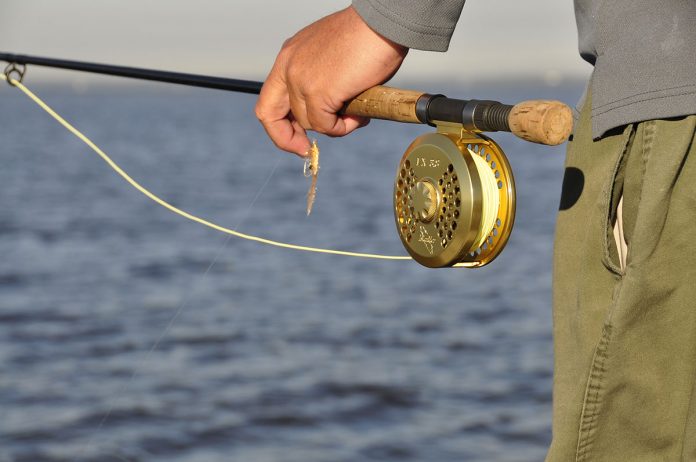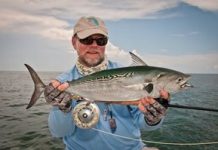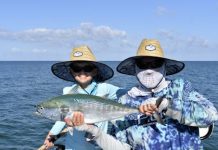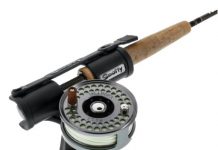The Secret to Success with Artificials 
By CAPT. PAT DAMICO
Why do the same people consistently catch fish with artificial lures and flies? It can’t be luck. Have you ever shared a boat with a companion who constantly out fished you, even though you both used the same equipment? What are some of the variables that you could improve and move you closer to being one of the ten percent who catch ninety percent of the fish? Is there any single factor that is more important than others? Is presentation, the way it appears to the fish, more important than lure selection? Absolutely!
A recent trip with Capt. Mel Berman had us drifting the flats, his favorite venue, while we cast artificials searching for a variety of shallow water species. Mel was telling me how many times he gets the same question from readers and listeners about using a lure, or line, he recommends, and not having any success. “My grandson Matt used both lures and line successfully since he was eight years old,” he quipped. Of course a big reason for Matt’s success was that Mel started him with proper equipment and held his hand through the learning process. Matt also didn’t have any bad habits to break. As a guide, I have clients that have varied experience, both good and bad. A person who can throw a cast net expertly and fish successfully with greenbacks could be a complete failure with artificials. A fisherman who used jigs and crank baits successfully for bass and walleyes will usually have very little trouble adapting his knowledge to fishing the saltwater shallows. He can cast, is familiar with equipment, and has confidence in being able to catch fish with a variety of lures.
If there is a single factor, other than being where the fish are, that will guarantee consistent results it is having very good line control. What do I mean? An accurate cast with a fly or artificial is complemented by the fisherman’s ability to monitor and control the artificial even before it hits the water’s surface. I’ll separate this into spinning and baitcasting, since they are very similar, and fly fishing.
All good casting techniques have one thing in common. The caster stops the rod to cause it to unload. If you have the weight of the lure loading, or bending the rod as it is brought forward, a crisp stop will let the rod do all the work and deliver the cast. In baitcasting, the thumb against the spool will stop the lure and deliver an accurate cast after the rod stops. A spinning reel is best controlled by feathering the line with your forefinger and finally stopping the line and lure with this same finger against the spool rim. Notice, I did not say by closing the bail. Manually closing the bail after the stop will also prevent a lot of problems that occur with the new braided lines. Have you ever had a fish grab your artificial as it hit the water? Were you prepared to set the hook, or did you miss the strike because of slack? Slack is the culprit in all casting and retrieving techniques and must be avoided. As soon as the lure touches the water’s surface, you should have a straight line between the reel, rod, and artificial. Many fish hit jigs, in particular, as they drop. A tight line will assure that the slightest tap will be transmitted to the rod tip and your hand holding the rod. The rod should also be positioned so that you have enough room to set the hook. Holding the rod too high will prevent a proper hook set. Crank baits, spinner type lures and swimming lures usually transmit a fish’s strike more effectively because the cranking of the reel keeps the line tight. Jig type lures, which include many of the soft plastics, require much more control because a take is usually very subtle. In both of the above, the lure is stopped so that it hits the target. It should travel in a straight line. Releasing the line too soon will cause it to go higher, creating slack and preventing good control.
Fly fishing has many more variables. When your rod hand stops on the forward stroke, unloading the fly rod, line is simultaneously released with your line hand allowing fly line to shoot toward the target. Your line hand forefinger and thumb allow the line to slide between them until the target is reached. Pinching these together on the line will stop the fly over the target for an accurate cast and immediate control as the line falls to the water’s surface. This technique allows perfect control of the line and transmits the most delicate strike to your fingers.
There are casts in fly fishing designed to intentionally introduce slack because of different stream and river conditions, but for our purposes the above technique will give excellent line control in most fishing situations.
Take your time. Concentrate and focus when fishing with artificials. Fish every cast like it is going to produce a fish. Your success ratio will improve dramatically. Good line control is the key to becoming an expert artificial fisherman in both fresh and saltwater.
A FFF Certified Fly Casting Instructor, Capt. Pat Damico guides on lower Tampa Bay and surrounding waters. Additional information is available at www.captpat.com, or by calling 727-504-8649.
- Captain’s Corner:Pat Damico - June 25, 2019
- Flat water makes seeing tarpon easier - May 17, 2017
- Warm rivers holding plenty of targets for fly fishermen - February 16, 2017











